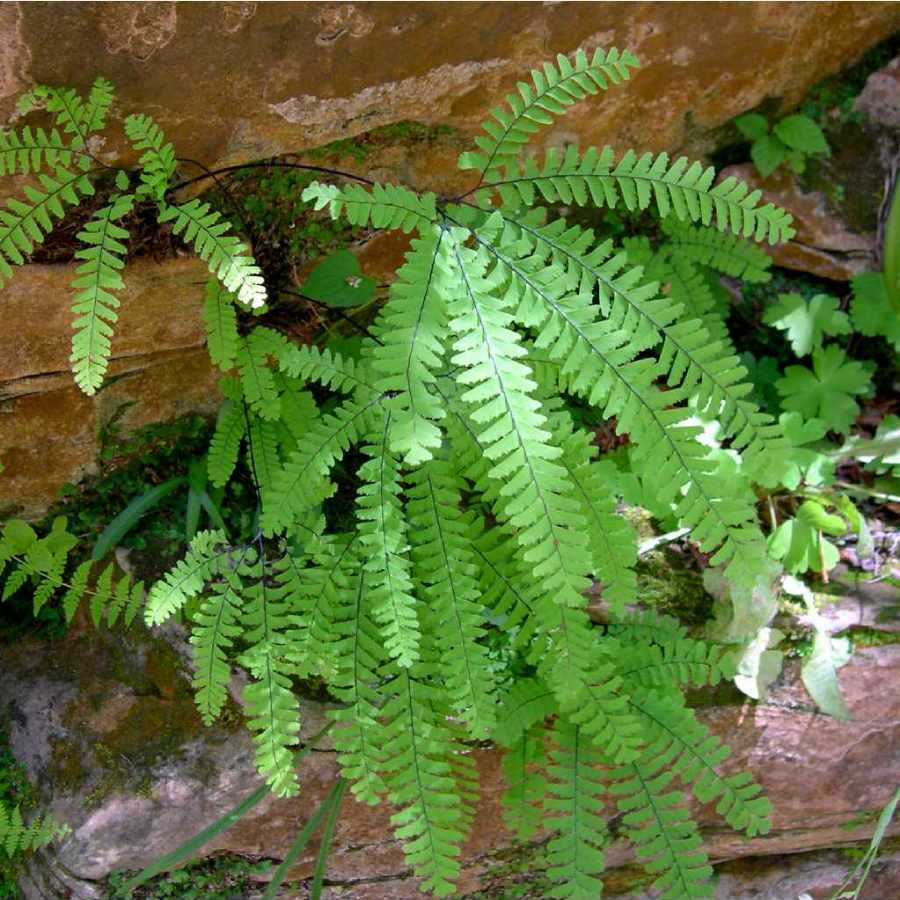
|
Pteridaceae |
|
|
Plants perennial [annual], on rock or terrestrial, of small (rarely large) stature . Stems compact to creeping, branched or unbranched, dictyostelic, bearing hairs and/or scales. Leaves monomorphic to dimorphic, circinate or noncircinate in bud . Petioles usually with persistent scales proximally, lacking spines; vascular bundles 1--several, roundish or crescent-shaped in cross section. Blades 1--6-pinnate, without laminar buds . Indument on petioles, rachises, costae, and blades, rarely absent or commonly of hairs, glands, and/or scales, occasionally of white or yellow farina. Veins pinnate or parallel in ultimate segments of blades, simple or forked, free or infrequently anastomosing in complex patterns. Sori borne abaxially on veins, often confluent with age and forming a continuous submarginal band, or sporangia densely covering abaxial surface (acrostichoid); receptacle not or only slightly elevated. Indusia (when present) formed by reflexed, recurved, or revolute leaf margin (false indusium). Sporangia stalk of 2--3 rows of cells; annulus vertical, interrupted by stalk; spores 64 or 32 (rarely 16) per sporangium. Spores all 1 kind, brown, black, or gray (rarely yellow), globose to globose-tetrahedral or trigonal, occasionally with prominent equatorial ridge, trilete, or trigonal, variously ornamented (usually cristate or rugose). Gametophytes green, aboveground, obcordate to reniform, sometimes asymmetric, usually glabrous (glandular-farinose in Notholaena ); archegonia and antheridia borne on abaxial surface, antheridia 3-celled. Considerable disagreement exists concerning the circumscription and proper name of this family. The taxa comprising the Pteridaceae in this treatment were assigned to the Sinopteridaceae and Pteridaceae by D. B. Lellinger (1985) and were included in five families by R. E. G. Pichi-Sermolli (1977). The broad concept followed here is similar (except for the exclusion of Ceratopteris ) to that espoused by R. M. Tryon and A. F. Tryon (1982), who applied the name Pteridaceae to the group. Until very recently, the newer name Adiantaceae was more commonly used. As represented in North America, Pteridaceae comprise three major evolutionary lines (the adiantoids, the pteroids, and the cheilanthoids). Characteristics holding the family together include abaxial (usually submarginal) sori that lack indusia or are protected by a reflexed or revolute leaf margin, spores that are usually globose-tetrahedral and trilete, and chromosome base numbers of 30 or 29 (rarely 27). The xeric-adapted members of the family (particularly the cheilanthoids) have undergone extensive parallel and convergent evolution, and they have frustrated attempts to produce a natural generic classification based on macromorphologic characteristics alone. Although some workers have aggregated species into a few large genera (e.g., J. T. Mickel 1979b), most tend to recognize smaller segregate genera based on a combination of morphologic, chromosomal, and biochemical data. The latter approach seems to provide a more useful, evolutionarily informative classification and is the one adopted here. Aspidotis and Notholaena are maintained here as distinct from Cheilanthes , and three recently described genera ( Argyrochosma , Astrolepis , and Pentagramma ) have been incorporated into the treatment. The reasons for these changes in generic circumscription are discussed under the individual genera.
Plants epiphytic or on rock. Roots abundant, covered with brown hairs. Stems short-creeping, branched, covered with scales with conspicuously thickened, clathrate cell walls. Leaves simple, entire, petioles indistinct. Veins (visible in cleared leaves) anastomosing on each side of midrib in row of long, polygonal areolae without included veinlets. Epidermis with spicular cells. Sori in submarginal groove on each side of midrib. Indusia absent, sporangia interspersed with branched soral paraphyses. Spores monolete or trilete. Gametophytes persistent, ribbonlike, much branched, and clone-forming by vegetative reproduction. Gemmae uniseriate, 2--5 mm, composed of 2--16 dark green body cells and 0--4 almost colorless, smaller rhizoid primordia cells. In species outside the flora, leaves may be much shorter and broader with more than one row of areolae and several soral lines on each side of the midrib. Rarely veins are free, and sporangia are scattered over the abaxial surface. Gametophyte gemmae may be much longer than found in the flora, may be platelike, or may be absent. Vegetative proliferation of gametophytes of this family allows the gametophyte generation to persist after sporophytes are produced. Although sporophytes of only one species, Vittaria lineata , are known in the flora, at least two additional species are represented by persistent gametophytes. Because sporophytes of V . graminifolia may occur in the flora, characteristics of its sporophyte are included in the key to species.
|
|
The PCC, and this data portal, were made possible by funding from the National Science Foundation’s
Advancing Digitization of Biological Collections (ADBC) program, grant numbers
1802504,
1802352,
1802134,
1802033,
1802270,
1802255,
1802239,
1802446,
1802305.
The pteridoportal taxonomic thesaurus is based on the
Checklist of Ferns and Lycophytes of the World, generously provided by Michael Hassler.



